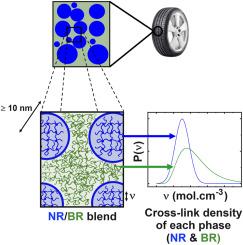Solid-state NMR of vulcanized natural rubber/butadiene rubber blends: Local organization and cross-linking heterogeneities
引用次数: 0
Abstract
Elastomer blends, among which natural rubber (NR) and butadiene rubber (BR), are involved in many components of the automotive/tire industry. A comprehensive understanding of their mechanical behavior requires, among other features, a detailed description of the cross-link density in these mixtures. In the case of vulcanized immiscible blends, the distribution of the cross-link density within each of the NR- and BR-rich domains is key information, but difficult to determine using the conventional approaches used for one-component cross-linked elastomers. In this study, the vulcanization within NR/BR blends is investigated using a robust 1H double-quantum (DQ) MAS recoupling experiment, BaBa-xy16. Two kinds of cross-linked NR/BR blends were considered with two different microstructures for the BR component. The bulk organization of the resulting blends was first probed by analyzing the 1H spin-lattice relaxation behavior. In a second step, BaBa-xy16 was used to investigate, in a selective way, the cross-link heterogeneities within NR/BR blends. In particular, for immiscible NR/BR mixtures, the distribution of the cross-link density between both phases was compared and the observed differences were discussed.

硫化天然橡胶/丁二烯橡胶共混物的固态核磁共振:局部组织和交联异质性
弹性体混合物,其中包括天然橡胶(NR)和丁二烯橡胶(BR),涉及汽车/轮胎工业的许多部件。要全面了解它们的机械性能,除其他特征外,还需要对这些混合物中的交联密度进行详细描述。在硫化不相溶混合物中,富含 NR 和 BR 的每个畴内的交联密度分布是关键信息,但很难用单组分交联弹性体的传统方法来确定。在本研究中,我们使用稳健的 1H 双量子 (DQ) MAS 重耦合实验(BaBa-xy16)研究了 NR/BR 共混物内部的硫化情况。研究考虑了两种交联 NR/BR 共混物,其中 BR 成分具有两种不同的微观结构。首先,通过分析 1H 自旋晶格弛豫行为来探测所得到的混合物的体组织。第二步,使用 BaBa-xy16 选择性地研究 NR/BR 共混物内部的交联异质性。特别是对于不相溶的 NR/BR 混合物,对两相之间的交联密度分布进行了比较,并对观察到的差异进行了讨论。
本文章由计算机程序翻译,如有差异,请以英文原文为准。
求助全文
约1分钟内获得全文
求助全文
来源期刊

Magnetic Resonance Letters
Analytical Chemistry, Spectroscopy, Radiology and Imaging, Biochemistry, Genetics and Molecular Biology (General)
自引率
0.00%
发文量
0
 求助内容:
求助内容: 应助结果提醒方式:
应助结果提醒方式:


